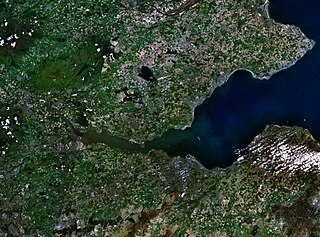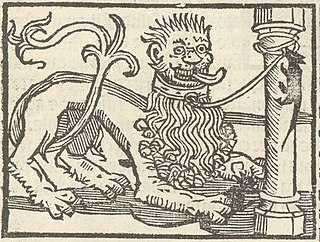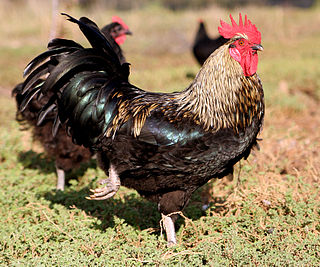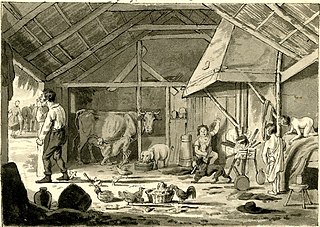
Aesop's Fables, or the Aesopica, is a collection of fables credited to Aesop, a slave and storyteller who lived in ancient Greece between 620 and 564 BCE. Of diverse origins, the stories associated with his name have descended to modern times through a number of sources and continue to be reinterpreted in different verbal registers and in popular as well as artistic media.
Rhyme royal is a rhyming stanza form that was introduced to English poetry by Geoffrey Chaucer. The form enjoyed significant success in the fifteenth century and into the sixteenth century. It has had a more subdued but continuing influence on English verse in more recent centuries.

Robert Henryson was a poet who flourished in Scotland in the period c. 1460–1500. Counted among the Scots makars, he lived in the royal burgh of Dunfermline and is a distinctive voice in the Northern Renaissance at a time when the culture was on a cusp between medieval and renaissance sensibilities. Little is known of his life, but evidence suggests that he was a teacher who had training in law and the humanities, that he had a connection with Dunfermline Abbey and that he may also have been associated for a period with Glasgow University. His poetry was composed in Middle Scots at a time when this was the state language. His writing consists mainly of narrative works. His surviving body of work amounts to almost 5000 lines.

The Lion and the Mouse is one of Aesop's Fables, numbered 150 in the Perry Index. There are also Eastern variants of the story, all of which demonstrate mutual dependence regardless of size or status. In the Renaissance the fable was provided with a sequel condemning social ambition.

"The Town Mouse and the Country Mouse" is one of Aesop's Fables. It is number 352 in the Perry Index and type 112 in Aarne–Thompson's folk tale index. Like several other elements in Aesop's fables, 'town mouse and country mouse' has become an English idiom.

A Satire of the Three Estates, is a satirical morality play in Middle Scots, written by makar Sir David Lyndsay. The complete play was first performed outside in the playing field at Cupar, Fife in June 1552 during the Midsummer holiday, where the action took place under Castle Hill. It was subsequently performed in Edinburgh, also outdoors, in 1554. The full text was first printed in 1602 and extracts were copied into the Bannatyne Manuscript. The Satire is an attack on the Three Estates represented in the Parliament of Scotland – the clergy, lords and burgh representatives, symbolised by the characters Spiritualitie, Temporalitie and Merchant. The clergy come in for the strongest criticism. The work portrays the social tensions present at this pivotal moment in Scottish history.

The Morall Fabillis of Esope the Phrygian is a work of Northern Renaissance literature composed in Middle Scots by the fifteenth century Scottish makar, Robert Henryson. It is a cycle of thirteen connected narrative poems based on fables from the European tradition. The drama of the cycle exploits a set of complex moral dilemmas through the figure of animals representing a full range of human psychology. As the work progresses, the stories and situations become increasingly dark.

The Testament of Cresseid is a narrative poem of 616 lines in Middle Scots, written by the 15th-century Scottish makar Robert Henryson. It is his best known poem. It imagines a tragic fate for Cressida in the medieval story of Troilus and Criseyde which was left untold in Geoffrey Chaucer's version. Henryson's cogent psychological drama, in which he consciously resists and confronts the routine depiction of Cressida (Cresseid) as simply 'false', is one of the features that has given the poem enduring interest for modern readers and it is one of the most admired works of northern renaissance literature. A modern English translation by Seamus Heaney, which also included seven of Henryson's fables from The Morall Fabillis, was published in 2009.
The Preiching of the Swallow, is the eighth poem in the accepted text of Robert Henryson's Middle Scots cycle, The Morall Fabillis of Esope the Phrygian written around the 1480s. Often seen as the most beautiful of the poems in the cycle, it is a very rich expansion of material ultimately derived from Aesop. It is the second of two poems in the cycle which feature the narrator as protagonist in the taill.

The Bannatyne Manuscript is an anthology of literature compiled in Scotland in the sixteenth century. It is an important source for the Scots poetry of the fifteenth and sixteenth centuries. The manuscript contains texts of the poems of the great makars, many anonymous Scots pieces and works by medieval English poets.

"The Taill of the Cok and the Jasp" is a Middle Scots version of Aesop's Fable The Cock and the Jewel by the 15th-century Scottish poet Robert Henryson. It is the first in Henryson's collection known as the Morall Fabillis of Esope the Phrygian. The Cok and the Jasp is framed by a prologue and a moralitas, and as the first poem in the collection it operates on a number of levels, and in all its parts, to introduce the larger cycle.

"The Taill of Schir Chanticleir and the Foxe" is Fabill 3 of Robert Henryson's cycle of thirteen Morall Fabillis composed in Scotland in the later fifteenth century. It is the first of the fable in the poem to be based on Reynardian and beast epic sources rather than on any strictly Aesopian original, although the closest match from Aesop might be The Dog, the Cock and the Fox.

The Cock and the Jewel is a fable attributed to Aesop and is numbered 503 in the Perry Index. As a trope in literature, the fable is reminiscent of stories used in Zen such as the kōan. It presents, in effect, a riddle on relative values and is capable of different interpretations, depending on the point of view from which it is regarded.

"Of Ane Blak-Moir" is a short poem in Scots by William Dunbar.

"The Wife of Auchtermuchty" is a Scots poem of the fifteenth or sixteenth centuries.

Quhy Sowld Nocht Allane Honorit Be is an anonymous allegorical poem of the fifteenth or sixteenth century written in Scots.

The Fox, the Wolf and the Husbandman is a poem by the 15th-century Scottish poet Robert Henryson and part of his collection of moral fables known as the Morall Fabillis of Esope the Phrygian. It is written in Middle Scots. As with the other tales in the collection, appended to it is a moralitas which elaborates on the moral that the fable is supposed to contain. However, the appropriateness of the moralitas for the tale itself has been questioned.
"The Paddock and the Mouse" is a poem by the 15th-century Scottish poet Robert Henryson and part of his collection of moral fables known as the Morall Fabillis of Esope the Phrygian. It is written in Middle Scots. As with the other tales in the collection, appended to it is a moralitas which elaborates on the moral that the fable is supposed to contain.

The Frog and the Mouse is one of Aesop's Fables and exists in several versions. It is numbered 384 in the Perry Index. There are also Eastern versions of uncertain origin which are classified as Aarne-Thompson type 278, concerning unnatural relationships. The stories make the point that the treacherous are destroyed by their own actions.
The Taill of the Lyoun and the Mous is the seventh poem in Robert Henryson's cycle The Morall Fabillis of Esope the Phrygian written in Middle Scots. In the accepted text of thirteen poems it thus occupies the central position in the cycle. This fact is further underlined by the stanza count of the full cycle, in which the fabill itself, 24 stanzas in length, makes an architectural division of the lave of the entire cycle, before and after, in two roundly equal sections of 200 stanzas each. The Taill of the Lyoun and the Mous is also the only fabill in the cycle to appear as part of a dream vision.




















